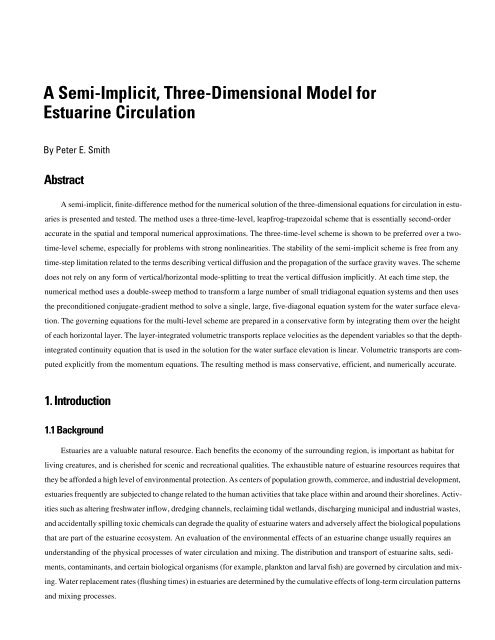A Semi-Implicit, Three-Dimensional Model for Estuarine ... - USGS
A Semi-Implicit, Three-Dimensional Model for Estuarine ... - USGS
A Semi-Implicit, Three-Dimensional Model for Estuarine ... - USGS
Create successful ePaper yourself
Turn your PDF publications into a flip-book with our unique Google optimized e-Paper software.
A <strong>Semi</strong>-<strong>Implicit</strong>, <strong>Three</strong>-<strong>Dimensional</strong> <strong>Model</strong> <strong>for</strong><br />
<strong>Estuarine</strong> Circulation<br />
By Peter E. Smith<br />
Abstract<br />
A semi-implicit, finite-difference method <strong>for</strong> the numerical solution of the three-dimensional equations <strong>for</strong> circulation in estu-<br />
aries is presented and tested. The method uses a three-time-level, leapfrog-trapezoidal scheme that is essentially second-order<br />
accurate in the spatial and temporal numerical approximations. The three-time-level scheme is shown to be preferred over a two-<br />
time-level scheme, especially <strong>for</strong> problems with strong nonlinearities. The stability of the semi-implicit scheme is free from any<br />
time-step limitation related to the terms describing vertical diffusion and the propagation of the surface gravity waves. The scheme<br />
does not rely on any <strong>for</strong>m of vertical/horizontal mode-splitting to treat the vertical diffusion implicitly. At each time step, the<br />
numerical method uses a double-sweep method to trans<strong>for</strong>m a large number of small tridiagonal equation systems and then uses<br />
the preconditioned conjugate-gradient method to solve a single, large, five-diagonal equation system <strong>for</strong> the water surface eleva-<br />
tion. The governing equations <strong>for</strong> the multi-level scheme are prepared in a conservative <strong>for</strong>m by integrating them over the height<br />
of each horizontal layer. The layer-integrated volumetric transports replace velocities as the dependent variables so that the depth-<br />
integrated continuity equation that is used in the solution <strong>for</strong> the water surface elevation is linear. Volumetric transports are com-<br />
puted explicitly from the momentum equations. The resulting method is mass conservative, efficient, and numerically accurate.<br />
1. Introduction<br />
1.1 Background<br />
Estuaries are a valuable natural resource. Each benefits the economy of the surrounding region, is important as habitat <strong>for</strong><br />
living creatures, and is cherished <strong>for</strong> scenic and recreational qualities. The exhaustible nature of estuarine resources requires that<br />
they be af<strong>for</strong>ded a high level of environmental protection. As centers of population growth, commerce, and industrial development,<br />
estuaries frequently are subjected to change related to the human activities that take place within and around their shorelines. Activ-<br />
ities such as altering freshwater inflow, dredging channels, reclaiming tidal wetlands, discharging municipal and industrial wastes,<br />
and accidentally spilling toxic chemicals can degrade the quality of estuarine waters and adversely affect the biological populations<br />
that are part of the estuarine ecosystem. An evaluation of the environmental effects of an estuarine change usually requires an<br />
understanding of the physical processes of water circulation and mixing. The distribution and transport of estuarine salts, sedi-<br />
ments, contaminants, and certain biological organisms (<strong>for</strong> example, plankton and larval fish) are governed by circulation and mix-<br />
ing. Water replacement rates (flushing times) in estuaries are determined by the cumulative effects of long-term circulation patterns<br />
and mixing processes.

















